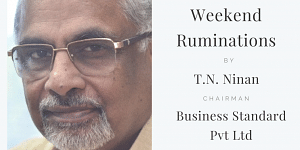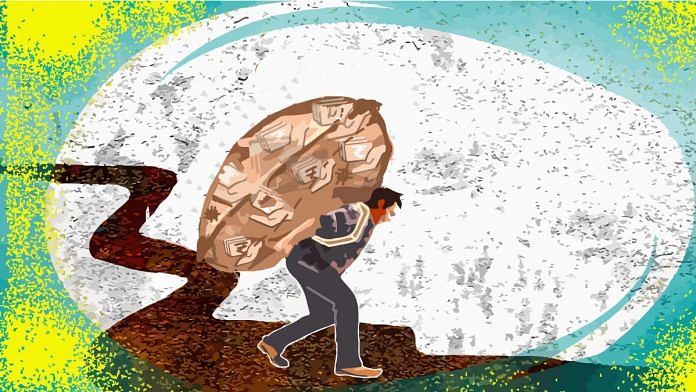We have heard these last few years about the twin-debt problem faced by companies and banks. We’ve read reports like Credit Suisse’s ‘House of Debt’, on companies that don’t have the earnings to pay interest on debt, let alone the principal. And of course we have read more than we would wish to about how banks have been writing off record sums of bad loans. So far, though, no one seems to have looked at the extent of money that is being borrowed by individuals, and the rising levels of household debt. Time to look at it when the consumption engine that has kept the economy going through a multi-year investment slowdown has stopped firing as before.
Individual or household financial stress is usually the result of lost jobs or livelihoods, and there is some of that. Look at depressed farm incomes, the fate of Jet Airways, or the effects of demonetisation. But there seems to be a deeper problem building up, one that is not linked to economic downswings or disruptions. Personal debt has been climbing and we must ask whether the burden of repayment is eating into disposable incomes — especially if loans taken for housing have to be repaid even when the housing project is stuck. Take a look at the numbers.
 Between 2013-14 and 2017-18, according to the Reserve Bank of India’s (RBI’s) ‘Handbook of Statistics on the Indian Economy’, personal loans given by banks went up in by 89 per cent to Rs 19.1 lakh crore. This, when private consumption increased by only 53 per cent, and overall non-food credit went up by an even more sedate 39 per cent. There was an increase of 82 per cent in borrowing for housing, 54 per cent for consumer durables, and 78 per cent for vehicles. The most striking was a 154 per cent increase in “other personal loans”, even as credit card outstanding went up by an even bigger 176 per cent. The only modest increase was for education loans (up about 16 per cent).
Between 2013-14 and 2017-18, according to the Reserve Bank of India’s (RBI’s) ‘Handbook of Statistics on the Indian Economy’, personal loans given by banks went up in by 89 per cent to Rs 19.1 lakh crore. This, when private consumption increased by only 53 per cent, and overall non-food credit went up by an even more sedate 39 per cent. There was an increase of 82 per cent in borrowing for housing, 54 per cent for consumer durables, and 78 per cent for vehicles. The most striking was a 154 per cent increase in “other personal loans”, even as credit card outstanding went up by an even bigger 176 per cent. The only modest increase was for education loans (up about 16 per cent).
These numbers on borrowings are compelling when placed against the figures for household savings, which, in the three years to 2016-17, went up by just 18 per cent, while physical household savings actually declined, though fractionally. The household figure for savings includes unincorporated enterprises, so the numbers are not strictly comparable. Nevertheless, the growing tendency to borrow more to consume is clear: The ratio between borrowings and overall consumption (including of the daily necessities) moved up in four years from 15.6 per cent to 19.3 per cent.
That’s just bank credit. There is then the money that people borrow from non-banking financial companies (NBFCs), usually for housing and cars but also for consumer durables and spending occasions like weddings. RBI numbers suggest that banks account for only about two-thirds of household financing, and the overall financial liabilities of households went up by Rs 6.7 lakh crore in 2017-18. This was an astonishing 80 per cent step up from the increase in (not total) liabilities of a year earlier.
India’s household debt in relation to its GDP is low — barely 11 per cent — compared to the other BRICS countries: 17 per cent in Russia, 26 per cent in Brazil and 48 per cent in China. But loans have to be repaid out of disposable income. This will be lower in India, where most people still live hand-to-mouth, than in the rest of BRICS, which has per capita income about five times India’s. For that reason, straight comparisons with such countries on the levels of personal debt can be misleading. That apart, at their present rates of growth, personal loans in India could well become the largest category of bank credit in just two or three years, replacing large industry and services which lead the tables now. Bank credit to all of industry, for instance, grew just 7.3 per cent in the four years to 2017-18. The financing of households is fine if incomes keep growing. If not, high debt levels could begin to bite, and we will have a double whammy.
By Special Arrangement with Business Standard
Also read: Top universities go out of reach as banks reject students after education loans turn bad




Worrisome indeed, thanks Mr Ninan for pointing it out. But this trend of individuals’ borrowing more when individual incomes haven’t grown in step, making it difficult for the borrowers’ capacity to repay loans, coming in last few years after Mr Modi came to power, points towards another disturbing possibility. Just as the Bhaktas thought that they could take police inspectors under their control by marching in huge numbers to police stations and creating mayhem there if the law-enforcing personnel did not bend to their wishes, could it be that these Bhaktas also thought that they could take similar liberties with bank managers and browbeat them into dispensing loans which otherwise the managers may not have found wise to dispense? What I am saying is, just as larger borrowers are said to have been favored if they had saffron credentials, could it be that EVEN THE INDIVIDUAL BORROWERS were also favored for similar reasons?
Frankly, it seems very plausible to me. I agree I have been critical of the BJP and Mr Modi, but going by simple logic the above looks not only very plausible to me but THE ONLY REASON for the soup-dish Mr Ninan has dished out to us. Our society is sloshing in soup. We are all in soup.
The key fact here is personal loans as a % of GDP are quite low and lowest of BRICS countries. The loans for vehicles, housing and consumer durables are being obtained by people who have a steady job as opposed to people who have lost their jobs. The savings are declining because people are making payments for the loans they have taken. Claiming that the savings are declining and loans are going up and as a result we are in danger of accumulating non-performing loans seems to be missing that crucial point. People arent making these payments out of disposable income. Rather disposable income is leftover income after making these payments. I think the author is seriously missing that point.
Who cares as long as we keep tackling terrorirsts in their den!
Whichever way one looks at it, stress is building up in the system. We know how it is released in geology …
True!
Very disturbing trend. Thanks Mr.Ninan for the timely article.
You write very well and clearly, unlike Bhalla in Indian Express who uses data to confuse people. Your clarity matches that of Krugman in the NYT. Congratulations.
Coming back to what you’ve written, once the euphoria of Modi’s victory passes, a lot of problems that have been festering will come out in the open. I doubt Modi has the right team to find the solutions. Time will tell.
True to an extent. But Bhalla gets bang on correct with most of his data and the projections he makes from that data.
Lol. True statement about Surjit Bhalla. Like a true one-trick pony that he is…the guy is fixated on lower interest rates being the solution for all economic problems. But i disagree on one thing that you said ‘once the euphoria of modi’s victory passes’. The lesson from this election has been that Modi will never let that pass. He is a complete political master with lots of tricks up his sleeve.
Agreed! But he’ll only be floored by the economy. If the economy improves and he takes bold steps e.g. closing down -not selling – Air India, we will need him for a long time. Otherwise he’ll be shown the door by the voters. We shall see soon. There are too many dark clouds on the economic and social horizon.